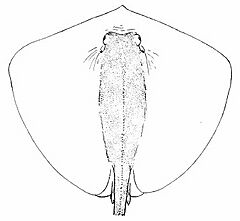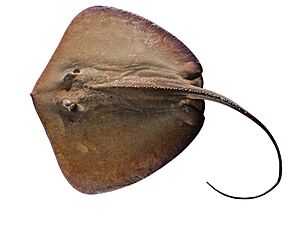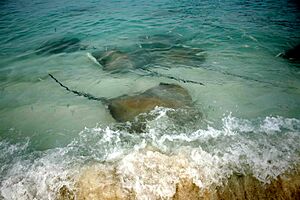Jenkins' whipray facts for kids
Quick facts for kids Jenkins' whipray |
|
|---|---|
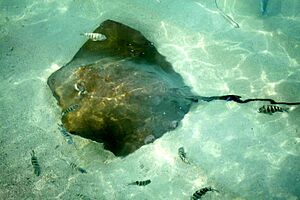 |
|
| Conservation status | |
| Scientific classification | |
| Genus: |
Pateobatis
|
| Species: |
jenkinsii
|
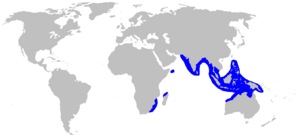 |
|
| Range of the Jenkins' whipray | |
| Synonyms | |
|
|
The Jenkins' whipray (Pateobatis jenkinsii) is a type of stingray. It lives in warm waters across the Indo-Pacific region. You can find it from South Africa all the way to northern Australia. This large ray can grow up to 1.5 meters (about 5 feet) wide. It has a wide, diamond-shaped body and a long, thin tail that looks like a whip.
The Jenkins' whipray has special heart-shaped bumps on its skin. These bumps run from its eyes all the way to its tail. It also has a line of big, spear-like thorns down its back. This ray is usually yellowish-brown on top and white underneath. Its tail turns grayish past its stinging spine. Sometimes, there's a spotted version of this ray. It was once thought to be a different species called the dragon stingray.
This stingray mostly eats small bony fish and crustaceans. It likes to live in shallow, sandy, or muddy areas less than 50 meters (about 164 feet) deep. Female Jenkins' whiprays give birth to live young. They feed their babies inside their bodies with a special "uterine milk." People often catch this species for its skin, which is valuable because of its large thorns. Its meat and cartilage can also be sold. The International Union for Conservation of Nature (IUCN) lists the Jenkins' whipray as a Vulnerable animal. This is because too much fishing in places like Southeast Asia has caused its numbers to drop. However, it is safer in northern Australia.
Contents
About the Jenkins' Whipray's Name
The first Jenkins' whiprays known to science were two adult males. They were about 1 meter (3.3 feet) wide. A ship called the Golden Crown collected them near Ganjam, India. A Scottish zoologist named Nelson Annandale described them in 1909. He named the new species Trygon jenkinsii. This was to honor Dr. J. Travis Jenkins. Dr. Jenkins helped with the Golden Crown trip.
This ray has a few other common names. People sometimes call it the brown stingray, golden whip ray, or rough-back stingray. The Jenkins' whipray can look a lot like the pink whipray. Because of this, people have sometimes confused the two species in books and studies.
What Does the Jenkins' Whipray Look Like?
The body of the Jenkins' whipray is shaped like a diamond. It is quite thick in the middle. Its body is a bit wider than it is long. The front edges of its body are almost straight. They meet at a wide angle at its snout, which has a small tip. Its eyes are medium-sized. Right behind them are larger holes called spiracles. These help the ray breathe.
Between its long, thin nostrils, there is a short flap of skin. This flap has a finely fringed edge. The ray's mouth is wide and gently curved. Inside, it has four papillae, which are small, nipple-shaped bumps. The two inner bumps are shorter than the outer ones.
The ray's pelvic fins are small and narrow. Its tail is round and gets thinner towards the end. It does not have any folds of skin. The tail is a little longer than the ray's body is wide. It has one to three stinging spines on top. These spines are about a quarter of the way down the tail from its base.
The top of the ray's body feels bumpy. It has a wide band of heart-shaped bumps on its skin. These bumps start between the eyes and get widest at the "shoulders." They cover the entire tail. There are also one or more rows of large, spear-like thorns. These run down the middle of its back, from the center of its body to where the sting starts.
Most Jenkins' whiprays are a uniform yellowish-brown on top. The edges of their bodies and their undersides are white. The tail turns gray past the sting. This ray can grow up to 1.5 meters (about 5 feet) wide and 3 meters (about 10 feet) long.
Where the Jenkins' Whipray Lives
The Jenkins' whipray is quite common. It lives in warm, tropical waters across the Indo-Pacific region. However, its distribution is a bit spread out. You can find it off southeastern Africa, near Madagascar, and around the Socotra Islands near Yemen. It also lives in South and Southeast Asia, including the Philippines. You can also find it near New Guinea and northern Australia.
This ray lives on the bottom of the ocean. It usually stays close to shore in waters less than 50 meters (about 164 feet) deep. But it has been seen as deep as 100 meters (about 328 feet) off northwestern Australia. It prefers sandy or muddy bottoms. It often lives in lagoons and can even enter brackish water (water that is a mix of fresh and salt water).
Life and Habits of the Jenkins' Whipray
The Jenkins' whipray can be seen alone or in groups. There is some evidence that males and females might live separately. Small teleost fish (fish with ray fins) make up a large part of its diet. It also eats crustaceans like crabs and shrimp. One ray was seen swimming with a smalleye stingray off Tofo, Mozambique.
Like other stingrays, the Jenkins' whipray gives birth to live young. The baby rays first get their food from a yolk sac. Later, the mother produces a special "uterine milk" to feed them. Newborn rays are about 20 to 27 centimeters (8 to 11 inches) wide. Males become adults when they are about 75 to 85 centimeters (2.5 to 2.8 feet) wide.
Jenkins' Whipray and Humans
The skin of the Jenkins' whipray is very valuable because of its large thorns. Its meat and cartilage can also be used. People often catch this ray on purpose or by accident. This happens in many places where it lives, due to a lot of coastal fishing. Fishermen use nets that trap fish, bottom trawls, and seine nets. They also use longlines, but less often.
Many Jenkins' whiprays are caught by an Indonesian fishing fleet. This fleet uses gillnets to catch other types of fish in the Arafura Sea. This fishing has caused a big drop in the number of stingrays overall. Off northern Australia, the Jenkins' whipray is more protected. It is not caught as much there because of rules like using Turtle Excluder Devices (TERs). The International Union for Conservation of Nature (IUCN) has listed this species as Vulnerable. This is because of the intense fishing and poor rules in Southeast Asia.



